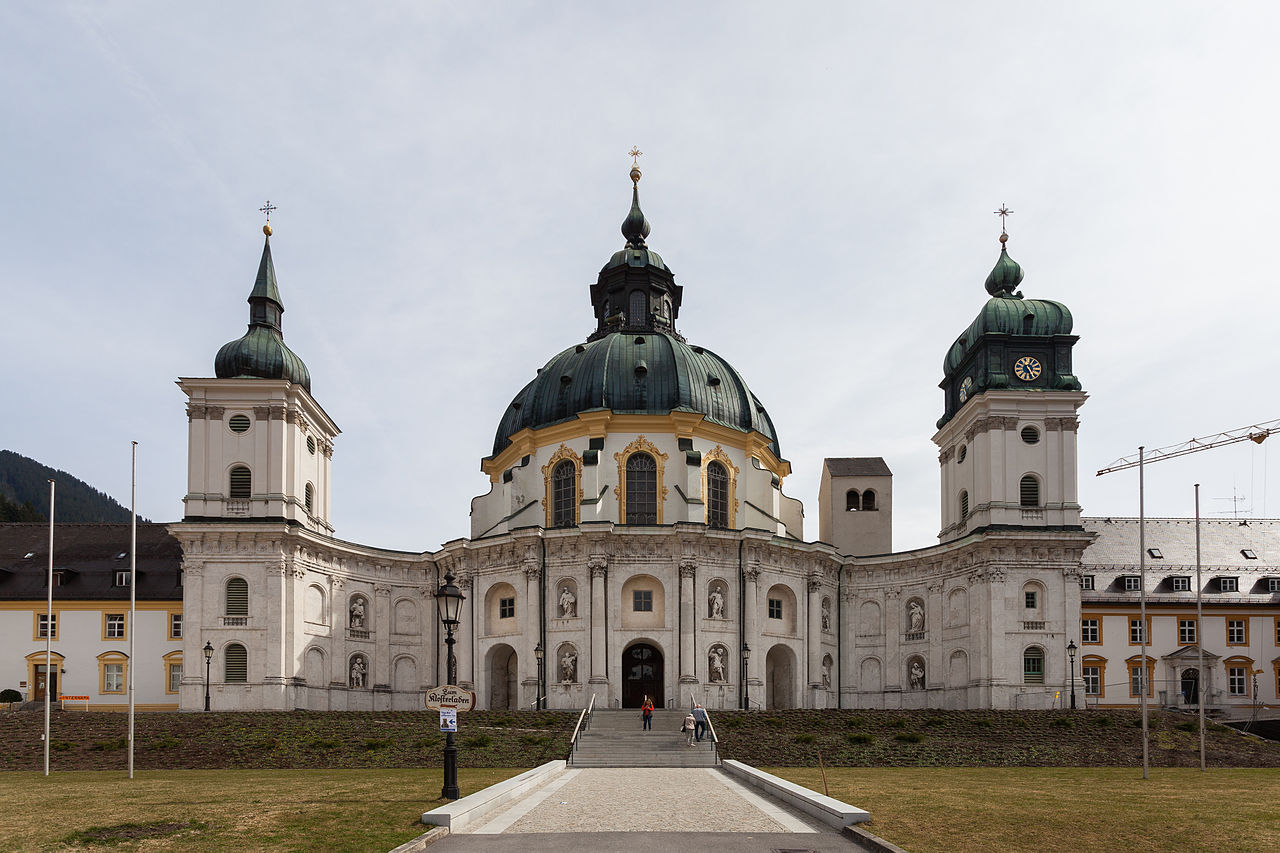Text from Wikipedia - the free encyclopaedia,
unless otherwise stated.

Ettal Abbey in Winter.
Photo: 31 December 2007.
Source: Own work.
Author: Mattana.
(Wikimedia Commons)

English: Ettal Abbey, Bavaria, Germany.
Español: Monasterio de Ettal, Baviera, Alemania.
Photo: 22 March 2014.
Source: Own work.
Author: Diego Delso.
(Wikimedia Commons)
Ettal Abbey was founded on 28 April 1330, Saint Vitalis of Milan's Feast Day, by Emperor Ludwig the Bavarian, in the Graswang Valley, in fulfilment of an oath on his return from Italy, on a site of strategic importance on the primary trade route between Italy and Augsburg.
The Foundation legend is that Ludwig's horse genuflected three times on the site of the original Church, where a statuette of The Virgin Mary ("Frau Stifterin" or the "Ettal Madonna"), of the Pisano School, now stands, a gift from Ludwig to his new Foundation. This statue soon became an object of Pilgrimage. The Church is dedicated to the Assumption of The Blessed Virgin.

English: Wechselburg Priory, formerly Wechselburg Abbey (Kloster Wechselburg)
and re-Founded in 1993. Five Monks from Ettal Abbey are located here.
Deutsch: Klosteranlage Wechselburg mit romanischer Basilika.
Photo: 24 July 2007.
Source: Own work.
Author: User:Kolossos.
(Wikimedia Commons)
The original Gothic Abbey Church, built between 1330 and 1370, was a modest structure in comparison to the great Churches of Mediaeval Bavaria.
The Abbey suffered great damage during the Reformation at the hands of the troops of Maurice of Saxony, but survived the troubles of The Thirty Years' War (1618–1648).

Ettal Abbey Side-Altars,
Bavaria, Germany.
Photo: 31 December 2007.
Source: Own work.
Author: Mattana.
(Wikimedia Commons)
Ettal Abbey's importance, as a place of Pilgrimage, grew with the new buildings and it became one of the most important Monasteries in the Alpine Region.
The Abbey was Dissolved in 1803, during the Secularisation of Church property in Bavaria. The site was acquired, in 1809, by Josef von Elbing and sold by his descendants in 1856 to Count Pappenheim. Some small building works were completed during the 19th-Century, principally the renovation of the façade and the twin Bell-Towers.

English: Ettal Abbey, Bavaria, Germany.
Español: Monasterio de Ettal, Baviera, Alemania.
Photo: 22 March 2014.
Source: Own work.
Author: Diego Delso.
(Wikimedia Commons)
The Assumption of The Blessed Virgin Mary,
Ettal Abbey.
Bavaria, Germany.
Photo: 31 December 2007.
Source: Own work.
Author: Mattana.
(Wikimedia Commons)
During the Winter of 1940 – 1941, the German Pastor and Theologian, Dietrich Bonhoeffer (1906–1945), spent some months at the Monastery as the friend and guest of the Abbot. Like Bonhoeffer, a number of those in the Ettal Community were involved in the Conspiracy against Hitler. While at Ettal Abbey, Bonhoeffer also worked on his book "Ethics". Catholic Priest, Rupert Mayer, was kept at the Abbey, from 1939 to 1945, by the Nazis, to prevent him from further Anti-Nazi Preaching.
In 1993, Ettal Abbey re-Founded the former Wechselburg Abbey, in Saxony, an old Monastery of The Augustinian Canons, as a Benedictine Priory.

Interior of the Dome,
Ettal Abbey.
Photo: 31 December 2007.
Source: Own work.
Author: Mattana.
(Wikimedia Commons)

The Organ,
Ettal Abbey.
Photo: 31 December 2007.
Source: Own work.
Author: Mattana.
(Wikimedia Commons)
The Monastery runs a brewery, a distillery, a bookstore, an Art Publishing House, an hotel, a cheese factory joint venture, and several smaller companies. The distillery produces Ettaler Kloster Liqueur, a herbal liqueur which, like that of the Carthusian Monks, comes in sweeter yellow, and more herbal green, varieties.

No comments:
Post a Comment